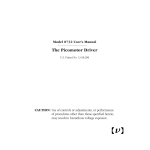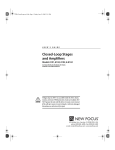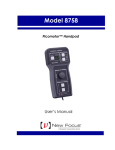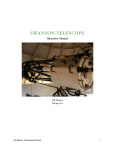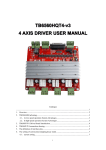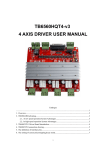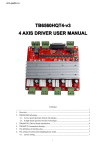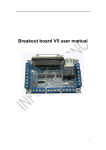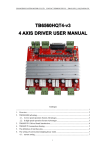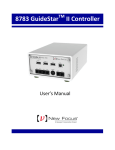Download Picomotor Drivers
Transcript
pico880113H.fm Page 1 Thursday, September 20, 2001 5:50 PM USER’S GUIDE Picomotor™ Drivers and Motorized Products For Model 8701, 8701-PCB, & 8801 Drivers U.S. Patents: #5,140,470, #5,168,168, #5,303,035, #5,394,049, #5,410,206, & #5,543,670 Voltages of up to 150 V are accessible inside the driver chassis, mounts, and Picomotors. While protection circuits are included, DO NOT operate the units with the driver or mount covers removed. If the cable of a mount or Picomotor is frayed, discontinue use and return it for repair. 5215 Hellyer Ave. • San Jose, CA 95138-1001 • USA phone: (408) 284–6808 • fax: (408) 284–4824 e-mail: [email protected] • www.newfocus.com pico880113H.fm Page 2 Thursday, September 20, 2001 5:50 PM Warranty New Focus, Inc. guarantees its products to be free of defects for one year from the date of shipment. This is in lieu of all other guarantees, expressed or implied, and does not cover incidental or consequential loss. Products described in this document may be covered by one or more of the following U.S. patents: #5,140,470, #5,168,168, #5,303,035, #5,394,049, #5,410,206, #5,543,670. Information in this document is subject to change without notice. Copyright 2001, 1999, 1998, New Focus, Inc. All rights reserved. The symbol and NEW FOCUS, Inc. are registered trademarks and Picomotor is a trademark of NEW FOCUS, Inc. Document Number 880113 Rev. H pico880113H.fm Page 3 Thursday, September 20, 2001 5:50 PM Contents Introduction 5 Overview. . . . . . . . . . . . . . . . . . . . . . . . . . . . . . . . . . . . . . . . . . . . . . . 5 Getting Started . . . . . . . . . . . . . . . . . . . . . . . . . . . . . . . . . . . . . . . . . 6 Picomotor Products and Accessories. . . . . . . . . . . . . . . . . . . . . 7 User Safety . . . . . . . . . . . . . . . . . . . . . . . . . . . . . . . . . . . . . . . . . . . . . 9 General Concepts . . . . . . . . . . . . . . . . . . . . . . . . . . . . . . . . . . . . . . . 9 Operation 11 Overview. . . . . . . . . . . . . . . . . . . . . . . . . . . . . . . . . . . . . . . . . . . . . . 11 Connecting Power . . . . . . . . . . . . . . . . . . . . . . . . . . . . . . . . . . . . . 11 Connecting Devices to the Single-Axis Driver . . . . . . . . . . . 12 Connecting Devices to the Multi-axis Driver . . . . . . . . . . . . 15 Driving Picomotor-driven products . . . . . . . . . . . . . . . . . . . . 17 Troubleshooting 23 Spontaneous Movement and Runaway Motors . . . . . . . . . . 23 Intermittent Operation . . . . . . . . . . . . . . . . . . . . . . . . . . . . . . . . 23 No Motion . . . . . . . . . . . . . . . . . . . . . . . . . . . . . . . . . . . . . . . . . . . . 24 Extending the Picomotor Cable . . . . . . . . . . . . . . . . . . . . . . . . . 24 Customer Service 25 Technical Support . . . . . . . . . . . . . . . . . . . . . . . . . . . . . . . . . . . . . 25 Service . . . . . . . . . . . . . . . . . . . . . . . . . . . . . . . . . . . . . . . . . . . . . . . . 25 Appendix I: Specifications 27 Picomotor Characteristics . . . . . . . . . . . . . . . . . . . . . . . . . . . . . . 27 Power Supplies . . . . . . . . . . . . . . . . . . . . . . . . . . . . . . . . . . . . . . . . 28 4-Pin and 6-Pin Connector Pinouts . . . . . . . . . . . . . . . . . . . . . 29 Vacuum-Compatible Connectors . . . . . . . . . . . . . . . . . . . . . . . 29 Control Input Pinouts. . . . . . . . . . . . . . . . . . . . . . . . . . . . . . . . . . 30 Picomotor Drivers Contents • 3 pico880113H.fm Page 4 Thursday, September 20, 2001 5:50 PM Appendix II: Replacing the Fuses 31 Changing Fuses in the Single-Axis Driver: . . . . . . . . . . . . . . . 31 Changing Fuses in the Multi-Axis Driver:. . . . . . . . . . . . . . . . 32 Appendix III: Installing 8701-PCB 4 • Contents 35 NEW FOCUS, Inc. pico880113H.fm Page 5 Thursday, September 20, 2001 5:50 PM Introduction Overview The New Focus Picomotor™ is an extremely compact high-resolution linear actuator. The Picomotor uses a piezo-electric transducer to turn a screw, resulting in incremental linear motion of less than 30 nm (100 nm for the Tiny Picomotor). Additionally, since the piezo is used to turn the screw and not to hold a position, the Picomotor can hold its position to better than 10 nm even when the power is off. Note: The Picomotor is not a traditional stepper motor. Since it relies on friction to turn a screw, there will be a slight variation in step size from pulse to pulse. See page page 10 for more details. Picomotors are available separately, to use as actuators or to replace micrometers, or built into mounts and stages. This manual covers the Model 8701 single-axis driver, Model 8701-PCB single-axis driver, and the Model 8801 multi-axis driver. Model 8701-PCB is the printed circuit board for the Model 8701 driver, is a component for building a single-axis driver into your own system. Once installed in your system, this unit will work just like the Model 8701 driver. See “Appendix III: Installing 8701-PCB” on page 35. You can control these drivers manually, using the Model 8620 Control Pad, or electronically, using either the analog or digital lines of the control input. Picomotor Drivers Introduction • 5 pico880113H.fm Page 6 Thursday, September 20, 2001 5:50 PM Getting Started For the Model 8701 or Model 8801 Picomotor driver, use the included power supply to plug in the Picomotor driver and connect your motorized product(s) to the Output jack(s) on the back of the driver. (Model 8701-PCB does not come with a power supply. See page 35 for more information on this model.) Figure 1 shows a typical configuration. Note: The single-axis drivers have one 4-pin output, for driving one Picomotor. The multi-axis driver has eight 6-pin outputs for driving up to eight motorized products, each of which may use up to three Picomotors. Adapters and switch boxes can extend the capabilities of the drivers. See page 8 for a list of accessories. Figure 1: Sample configuration with the multiaxis driver Picomotor & Rotary Stage Pic om oto rC on tro lP Motorized Mirror Mount ad 86 20 C Picomotor Adapter 8601 Input B Made in USA MASA Adapter A Control Pad 4 3 Model 8801 Multi-Axis Driver 5 6 Picomotor Driver 2 7 1 8 8801 Multi-Axis Driver Power Made in USA 1. For manual control of the driver, connect the Model 8620 Control Pad to the Control Input on the back of the driver. (For electronic control, you can connect a source to the driver. See page 17.) 2. If you are using the multi-axis driver or a switch box, use the selector switch to select which device you want to control. 6 • Introduction NEW FOCUS, Inc. pico880113H.fm Page 7 Thursday, September 20, 2001 5:50 PM 3. On the Control Pad, move the slider forward to drive the screw forward. The farther forward you push the slider, the faster the screw will turn. Move the slider backward to move the screw back. For multi-axis components, each slider will drive a different screw. For the single-axis drivers, only slider “A” will be active. Note: Be careful not to back the screw all the way out of the Picomotor. Picomotor Products and Accessories Motorized devices connect to the drivers using simple modular phone jack connectors. The single axis drivers have one 4-pin connector, capable of driving one Picomotor. The multi-axis driver has eight six-pin connectors for driving devices with more than one motor, such as mirror mounts. To use a device with a 4-pin connector in the multiaxis driver, you will need to use a Model 8601 multiaxis to single-axis (MASA) adapter. The following tables show our standard Picomotor drivers, devices, and, accessories, and lists their connector types. Picomotor Drivers Model # Picomotor Drivers Description Connectors 8701 Single-Axis Driver 1 x 4-pin 8701-PCB Printed circuit board (component for building a single-axis driver into your own system). This driver operates like the Model 8701. See page page 35 for installation instructions. 1 x 4-pin 8801 Multi-Axis Driver 8 x 6-pin Introduction • 7 pico880113H.fm Page 8 Thursday, September 20, 2001 5:50 PM Motorized Devices Picomotors Model # Description Connectors 8301– 8341 Standard Picomotor 1 x 4-pin 8301v– 8341v Vacuum-Compatible Picomotor teflon-insulated 28-gauge wires 8351 Tiny Picomotor 1 x 4-pin Stages and Positioners Model # Description Connectors 8401 Rotary Stage 1 x 4-pin 8071 4-Axis Stage 2 x 6-pin 8081, 8082 5-Axis Stage 2 x 6-pin Fiber Positioner 1 x 6-pin 8051 Optical Mounts Description Model # Connectors 8807– 8853 3-Axis Mirror Mounts 1 x 6-pin 8807 2-Axis Mirror Mount 2 x 4-pin 888x Pint-Sized Mounts 2 x 4-pin Accessories Model # 8 • Introduction Description Connectors 8620 Control Pad: for manual control of the picomotor driver. 15-pin Sub-mini D connector 8610 Switch Box: enables the single-axis driver to drive up to 8 Picomotors (not simultaneously). out: 1 x 4-pin in: 8 x 4-pin NEW FOCUS, Inc. pico880113H.fm Page 9 Thursday, September 20, 2001 5:50 PM Model # 8601 Description Multi-Axis to Single-Axis (MASA) Adapter: allows use of single-axis devices with the multi-axis driver or, with the switch box, multi-axis devices with the single-axis driver. Connectors 1 x 6-pin, 3 x 4-pin User Safety Voltages of up to 150 V are accessible inside the driver chassis, mounts, and Picomotors. Although protection circuits are included, do not operate the units with the driver or mount covers removed. If the wire of a mount or Picomotor is frayed, discontinue use and return it for repair. Please see “Appendix III: Installing 8701-PCB” on page 35 for safety information regarding that device. General Concepts The key element in our motorized mechanical line is the Picomotor. The Picomotor’s revolutionary design relies on the principles of static and dynamic friction. Two jaws grasp an 80-pitch screw, and a piezoelectric transducer slides the jaws in opposite directions. Figure 2: Schematic of the action of the Picomotor 80 Pitch Screw Two jaws grasp an 80-pitch screw Jaws Piezo Slow action of the piezo causes a screw rotation Fast action, due to inertia, causes no motion Picomotor Drivers Introduction • 9 pico880113H.fm Page 10 Thursday, September 20, 2001 5:50 PM Slow action of the Picomotor (high static friction) causes the screw to rotate while fast action (low dynamic friction) causes no rotation. By sending pulses with fast rise times and slow fall times, the piezo will rotate the screw counter-clockwise. Similarly, sending pulses with slow rise times and fast fall times rotates the screw clockwise. Note: The knob on the end of the drive screw provides inertial mass required for operation. Removal of the knob will prevent the Picomotor from functioning properly and void the warranty. The single-axis and multi-axis drivers generate the 120-V pulses required to drive the piezo in the Picomotor. The drive circuit consists of a voltagecontrolled oscillator (VCO), some logic elements, and a power field-effect-transistor circuit (FET) which produces the 120-V pulses. Step Size and Repeatability The Picomotor is not a stepper motor. Because it is a friction mechanism, it does not produce identical steps for each input pulse. Although the step size can vary slightly from pulse to pulse, it will always be less than 30 nm for the standard Picomotor (for the tiny Picomotor, step size will be less than 100 nm). In addition, when starting the motor from a standstill or changing its direction, the Model 8701 and Model 8801 drivers have to “bootstrap” the pulses up to a stable amplitude. This can result in a significant variance in step size for up to the first 10 pulses. Other factors that affect the angle change and linear travel per pulse include direction of rotation, load, temperature, and life and wear of the unit. 10 • Introduction NEW FOCUS, Inc. pico880113H.fm Page 11 Thursday, September 20, 2001 5:50 PM Operation Overview Operating Picomotor devices is extremely easy. Connect the driver to the included power supply, plug in the motorized device(s), and connect the controller (either the handpad or an analog or digital signal source). Since some device/driver combinations require additional accessories, this chapter includes instructions on attaching devices to the single-axis driver and to the multi-axis driver. This is followed by instructions on controlling the driver using the handpad and on setting up electronic signal sources. Connecting Power For the Model 8701 and Model 8801 drivers, use the included power supply to plug in the Picomotor driver. Note: Each Model 8701 and Model 8801 Picomotor is shipped with a self-switching power supply suitable for use with voltages from 90–250 V. Specifications for the power supply can be found on page 28. For the Model 8701-PCB, users must supply their own power supply. See “Appendix III: Installing 8701-PCB” on page 35 for more information. Picomotor Drivers Operation • 11 pico880113H.fm Page 12 Thursday, September 20, 2001 5:50 PM Connecting Devices to the Single-Axis Driver The Model 8701 single-axis driver has one 4-pin connector, and on its own can only drive a single Picomotor or a rotary stage. Figure 3: The single-axis driver with a Picomotor and the control pad Picomotor Pic om otor Con trol Pad 86 20 C B A Model 8620 Control Pad Model 8701 Picomotor Driver Picomotor Driver 8701 Single-Axis Driver Power Made in USA You can use the single-axis driver with a Model 8610 switch box to connect up to 8 Picomotors (the motors cannot be driven simultaneously—use the switch box’s selector switch to choose which motor you are controlling). To drive devices with multiple motors that use 6-pin connectors, you will also need to use a Model 8601 adapter (see Figure 4). Note: The Model 8807 2-axis mount uses two 4-pin connectors. You can connect it to the switch box without using adapters. Connecting Picomotors and Rotary Stages Required Accessories: None needed to run a single Picomotor or rotary stage. To run more than one, you will need the Model 8610 switch box, which allows the driver to control up to 8 motors. To connect one Picomotor or rotary stage, connect the device’s 4-pin connector to the Output connector on the back of the driver. 12 • Operation NEW FOCUS, Inc. pico880113H.fm Page 13 Thursday, September 20, 2001 5:50 PM To connect multiple 4-pin devices, snap the devices’ connectors into the switch box and connect the switch box to the driver with the provided cable. Vacuum-compatible Picomotors Vacuum-compatible Picomotors do not come with attached connectors. Use the wiring diagrams on page 29 to attach the wire leads to 4-pin connectorized cables. Connecting Mounts and Stages Using a mount or a translation stage with the Model 8701 single-axis driver requires a Model 8610 switch box and one or more Model 8601 MASA adapters. Figure 4: Typical setup for controlling a multi-axis device with the single-axis driver Model 8809 Motorized Mount Model 8601 Adapter A B C Model 8610 Switch Box Pic om oto rC on tro lP ad 4 3 86 5 6 Switch Unit Input 8610 20 2 7 1 8 C B A Made in USA Model 8620 Control Pad Model 8701 Picomotor Driver Picomotor Drivers Picomotor Driver 8701 Single-Axis Driver Power Made in USA Operation • 13 pico880113H.fm Page 14 Thursday, September 20, 2001 5:50 PM 2-Axis Mounts, including Pint-sized mounts Required Accessories: Model 8610 switch box. 1. Connect each of the device’s 4-pin connectors to an Output connector on the switch box. 2. Connect the 4-pin input on the switch box to the 4-pin output on the driver. XY Fiber Positioners and 3-Axis Mounts Required Accessories: Model 8610 switch box, Model 8601 MASA adapter, and two or three 4-pin to 4-pin cables (one per axis). Note: 4-pin to 4-pin IDC modular cables are available from electronic-component catalog companies such as Digikey. Use 4-pin to 4-pin reversed style cables. 1. Connect the device’s 6-pin connector to the Output jack on the adapter. The adapter is shipped with a 6-pin cable. For this application, you will not use this cable. 2. Connect the A, B, and C jacks on the adapter to three of the jacks on the switch box, using 4-pin to 4-pin cables (not included). 3. Connect the 4-pin input on the switch box to the 4-pin output on the driver. 4- and 5-Axis Stages Required Accessories: Model 8610 switch box, two Model 8601 MASA adapters, and four or five 4-pin to 4-pin cables (one per axis: see note above). 1. Connect one of the stage’s 6-pin connectors to the Output jack of an adapter. Adapters are shipped with 6-pin cables. For this application, you will not use these cables. 2. Connect the A, B, and C jacks on the adapter to three of the jacks on the Switch Box, using 4-pin to 4-pin cables (not included). 14 • Operation NEW FOCUS, Inc. pico880113H.fm Page 15 Thursday, September 20, 2001 5:50 PM 3. Repeat steps 1 and 2 for the other 6-pin connector. 4. Connect the 4-pin input on the switch box to the 4-pin output on the driver. Connecting Devices to the Multi-axis Driver The multi-axis driver has eight 6-pin connectors, so you can connect up to 24 individual Picomotors, and can drive up to 3 motors at once. To drive devices with 4-pin connectors, such as Picomotors and rotary stages, you will need to use multi-axis to single-axis adapters (Model 8601). Each adapter is capable of handling 3 single-axis devices. Figure 5: Sample configuration with the multiaxis driver Picomotor & Rotary Stage Pic om oto rC on tro lP Motorized Mirror Mount ad 86 20 C Picomotor Adapter 8601 Input B Made in USA Picomotor Adapter A Control Pad 4 3 Model 8801 Multi-Axis Driver 5 6 Picomotor Driver 2 7 1 8 8801 Multi-Axis Driver Power Made in USA Connecting Picomotors and Rotary Stages Required Accessories: 1 Model 8601 Single-axis to multi-axis adapter for every 3 devices. 1. Snap the device’s 4-pin connector into one of the three 4-pin connectors, A, B, or C, on an adapter. Picomotor Drivers Operation • 15 pico880113H.fm Page 16 Thursday, September 20, 2001 5:50 PM 2. Connect the adapter’s 6-pin Input connector to one of the Output jacks on the multi-axis driver. Vacuum-compatible Picomotors Vacuum-compatible Picomotors do not come with attached cords and connectors. Use the wiring diagrams on page 29 to attach the wire leads to the supplied 4-pin connectorized cable. Connecting Mounts and Stages Many New Focus mounts and stages use 6-pin connectors, which are directly compatible with the multi-axis driver. For devices with 4-pin connectors, you will need to use Model 8601 MASA adapters. 2-Axis Mounts, Including Pint-sized Mounts Required Accessories: One Model 8601 MASA adapter for each mount. 1. Connect the mount’s two 4-pin connectors to two of the 4-pin connectors on the adapter. 2. Using the 6-pin cord supplied with the adapter, connect the Input on the adapter to one of the Output connectors on the driver. Note: You can use the remaining connector on the adapter to run another single-axis Picomotor device, such as an MRA. XY Fiber Positioners and 3-Axis Mounts Required Accessories: None. Connect the device’s 6-pin connector to one of the Output jacks on the driver. 4- and 5-Axis Stages Required Accessories: None. Connect the stage’s two 6-pin connectors to two of the Output jacks on the driver. 16 • Operation NEW FOCUS, Inc. pico880113H.fm Page 17 Thursday, September 20, 2001 5:50 PM Driving Picomotor-driven products You can drive motorized devices using a hand-held control pad, or by connecting an analog or digital signal to the driver. You can also manually turn the screw to adjust its position. Take care not to drive the screw completely out of the Picomotor housing. Removing the screw will collapse the Picomotor and void the warranty. Using the Control Pad 1. Connect the 15-pin subminiature D-connector of the control pad to the control input of either the single-axis or the multi-axis driver. 2. Plug in the driver’s power supply. 3. If you are using a switch box or the multi-axis driver, use the selector switch to choose which unit you want to control. 4. The sliders labeled “A”, “B”, and “C” on the control pad adjust the corresponding Picomotors. Note: When using the control pad with the single-axis driver, the slider labeled “A” will operate the Picomotor. Figure 6: The Model 8620 Picomotor control pad P m ico oto rC on tro lP ad 86 20 C B A For wa rd Bac kw ard 5. Move a slider up to drive its corresponding screw clockwise and forwards. Move the slider down to drive the screw counter-clockwise and back. Picomotor Drivers Operation • 17 pico880113H.fm Page 18 Thursday, September 20, 2001 5:50 PM Analog Control To drive the Picomotors with an analog source, connect a variable ±2.5-V source to the analog input lines of the Control Input connector. AnalogA AnalogC 2 3 1 9 10 P2.5 4 GND 11 6 5 12 13 7 15 8 AnalogB Figure 7: The analog input lines for the Control Input (pinouts looking at the back of the driver) N2.5 When using the multi-axis driver or switch box, select which device you want to control using the selector switch on the front of the driver or on the switch box. 14 Note: Picomotor Driver Input Connector—Analog Lines Note: Pin Name Description 1 AnalogA Channel A analog input 2 AnalogC Channel C analog input 3 N2.5 -2.5 V referenced to GND 4 P2.5 +2.5 V referenced to GND 6 AnalogB Channel B analog input 11 GND Ground The Model 8701 single-axis driver only uses channel A. For a description of all the connector’s pinouts, see page 30. The Picomotor driver converts signals from these inputs into 1-ms pulses, which the piezo in the Picomotor then uses to turn the screw. 18 • Operation NEW FOCUS, Inc. pico880113H.fm Page 19 Thursday, September 20, 2001 5:50 PM Step Rate and Direction for Analog Control Negative voltages turn the screw clockwise and forward. Positive voltages turn the screw counterclockwise and backward. The voltage range is -2.5 V to +2.5 V. Reference voltages of -2.5 V and +2.5 V are present in the D connector. The pulse frequency is a function of the magnitude of the voltage. ±2.5 V gives the maximum pulse rate of 1000 pulses/second; ±0.25 V gives you the minimum pulse rate of 1 pulse/second. 1200 1000 Pulses/second Figure 8: For analog control, pulse rate is a function of the magnitude of the voltage 800 600 400 200 0 0.0 0.5 1.0 1.5 2.0 2.5 Voltage Magnitude, |V| Direction CW (forward) Rotation Voltage -0.25– -2.5 Pulses/sec 1 – 1000 No rotation (dead zone) -0.25– +0.25 0 CCW (backward) Rotation +0.25– +2.5 1 – 1000 There is a “dead zone” between -0.25 and +0.25 V to prevent background noise from causing unwanted pulses. Reference all voltages to the GND line (pin 11). Note: All inputs are pulled up through 4.7-kΩ resistors and should be left open when not in use. Current draw is less than 5 mA. The analog signals must be within the range ±10 V to prevent damage to the drive electronics. Picomotor Drivers Operation • 19 pico880113H.fm Page 20 Thursday, September 20, 2001 5:50 PM Digital Control To drive the Picomotor digitally, connect a voltage source to the digital input lines of the Control Input connector. The driver has one pair of digital step and direction lines for each of the channels, A, B, & C. 1 2 9 StepC 3 10 11 GND 12 Clock 4 +5 13 DirC 5 14 DirB 6 15 8 7 StepA Figure 9: The digital step and direction lines for the Control Input (pinouts looking at the back of the driver) StepB When using the multi-axis driver or switch box, select which device you want to control using the selector switch on the front of the driver or on the switch box. DirA Note: Picomotor Driver Input Connector—Digital Lines 20 • Operation Pin Name Description 5 +5 7 StepB Channel B digital step control line (negative edge) 8 StepA Channel A digital step control line (negative edge) 9 StepC Channel C digital step control line (negative edge) 11 GND Ground 12 Clock 1-kHz internal clock 13 DirC Channel C digital direction control line 14 DirB Channel B digital direction control line 15 DirA Channel A digital direction control line 5 V DC referenced to GND NEW FOCUS, Inc. pico880113H.fm Page 21 Thursday, September 20, 2001 5:50 PM Note: The Model 8701 single-axis driver only uses channel A. For a description of all the connector’s pinouts, see page page 30. Step Rate and Direction for Digital Control Direction: DIRA, DIRB, and DIRC are direction inputs for screw channels A, B, and C. A high level (+5 V) on a line indicates clockwise (CW) rotation for that channel; a digital low (0 V) indicates counterclockwise (CCW) rotation. For easier synchronization, we recommend keeping a level on these lines (instead of sending a directional pulse along with the step signal). To ensure step pulses are correctly completed, do not change direction within 1.5 ms of a step. Step: Initiate a step by sending a 5-V pulse on one of the step lines. The falling edge of the pulse initiates the Picomotor step motion. The maximum edge rate is 1 kHz: sending step signals at a higher rate will not increase the speed of the Picomotor. The minimum pulse width that the driver can recognize is 20 nsec. Note: Picomotor Drivers All inputs are pulled up through 4.7-kΩ resistors and should be left open when not in use. Current draw is less than 5 mA. Operation • 21 pico880113H.fm Page 22 Thursday, September 20, 2001 5:50 PM 22 • Operation NEW FOCUS, Inc. pico880113H.fm Page 23 Thursday, September 20, 2001 5:50 PM Troubleshooting Spontaneous Movement and Runaway Motors Spontaneous movement of the Picomotor may occur if it is in a high-noise area. If you are experiencing this problem, move the Picomotor control and device cables away from noise sources. Make sure the device cables are not running over the driver boxes. A loose connection between the Control Input on the back of the driver and the handpad or signal source may also cause spontaneous movement or even a runaway motor. Make sure to use the captive attachment screws to secure the connector to the Control Input. Intermittent Operation If the Picomotor is only operating intermittently, it may be that you are using a device with a 4-pin connector in the multi-axis driver, which has 6-pin connectors. 4-pin connectors will not seat properly in 6-pin sockets, causing intermittent motion. To use a 4-pin connector with the multi-axis driver, you should use the Model 8601 adapter. For vacuum-compatible Picomotors, ensure that the cable impedance is <2 Ω. We recommend using twisted pair wiring to limit cross-talk. Picomotor Drivers Troubleshooting • 23 pico880113H.fm Page 24 Thursday, September 20, 2001 5:50 PM No Motion If there is no motion from the Picomotor, check the cable connections (see “Intermittent Operation,” above). For the multi-axis driver and switch box, check that the selector switch is on the correct setting for the motor you want to control. If the connections and selector switch all seem correct, you may need to replace a fuse. See “Appendix II: Replacing the Fuses” on page 31. Extending the Picomotor Cable You may extend Picomotor cables beyond their standard configurations, however the overall cable impedance must be <2 Ω to ensure proper operation. We recommend twisted pair or shielded wiring to limit cross talk and noise pick-up. 24 • Troubleshooting NEW FOCUS, Inc. pico880113H.fm Page 25 Thursday, September 20, 2001 5:50 PM Customer Service Technical Support Information and advice about the operation of any New Focus product is available from our technical support engineers. For quickest response, ask for “Technical Support” and know the model and serial number for your product. Hours: 8:00–5:00 PST, Monday through Friday (excluding holidays). Toll Free: 1-866-NUFOCUS (1-866-683-6287) (from the USA & Canada only) Phone: (408) 284-6808 Support is also available by fax and email: Fax: (408) 980-8883 Email: [email protected] We typically respond to faxes and email within one business day. Service In the event that your product malfunctions or becomes damaged, please contact New Focus for a return authorization number and instructions on shipping the unit back for evaluation and repair. Picomotor Drivers Customer Service • 25 pico880113H.fm Page 26 Thursday, September 20, 2001 5:50 PM 26 • Customer Service NEW FOCUS, Inc. pico880113H.fm Page 27 Thursday, September 20, 2001 5:50 PM Appendix I: Specifications Picomotor Characteristics Specifications Note: Picomotor Drivers Standard MRA Tiny MRA Linear Resolution: (see Note) <30 nm <100 nm Angular Resolution: (see Note) <0.6 mrad <2 mrad Linear Travel: Limited by screw length Limited by screw length Max. Load: 5 lbs (22 N) 1.5 lbs (6.7 N) Max. Speed: 0.64 mm/min 2–3 RPM 1 mm/min 2–3 RPM Temperature Range 10–40 ºC 10–40 ºC Est. Lifetime (continuous operation) 1000 hrs 200 hrs Since the Picomotor relies on friction to turn the screw, the actual angle change and linear travel per pulse varies a small amount with direction of rotation, load, temperature, and life of the unit. See page 10 for more information on step size. Appendix I: Specifications • 27 pico880113H.fm Page 28 Thursday, September 20, 2001 5:50 PM Power Supplies Picomotor drivers come with a self-switching international power supply. The power supply provides +5 V and ±12 V. The pinouts of the driver’s Power In connector are shown in Figure 10. Parameter Specification Input Voltage: Accepts 90–250 V AC Input Frequency: 47–440 Hz Output Current +5 V: 2 A max. +12 V: 250 mA max. -12 V: 250 mA max. Ripple: ±1% max. Regulation ±5% Size: 5.0" x 3.0" x 2.5" Power Supply Pinouts The following table and diagram detail the pinouts for the 5-pin DIN Power In connector on the back of the Model 8701 and 8801 Picomotor drivers. Figure 10: Power In connector (pinouts looking at the back of the driver) Pin 3 1 4 5 2 28 • Appendix I: Specifications Voltage 1 COM 2 Not Connected 3 +5 V 4 -12 V 5 +12 V NEW FOCUS, Inc. pico880113H.fm Page 29 Thursday, September 20, 2001 5:50 PM 4-Pin and 6-Pin Connector Pinouts Figure 11: Wiring diagrams for 4- and 6-pin connectors Standard Multi-axis Cable 8801 Output Connector Male 6-pin RJ-11 Female 6-pin RJ-11 Blue A Yellow A-Gnd Green B Red B-Gnd Black C White C-Gnd A 6 Ground 5 B 4 Ground 3 C 2 Ground 1 Standard Single-axis Cable 8701 Output Connector Male 4-pin RJ-11 Female 4-pin RJ-11 Yellow A-Gnd Green A Red Black A-Gnd 4 A 3 Not Connected Not Connected 2 Not Connected Not Connected 1 Tiny Single-axis Cable Male 4-pin RJ-11 White A-Gnd Black A Not Connected Not Connected Vacuum-Compatible Connectors Vacuum-compatible Picomotors are shipped without connectors attached. For these Picomotors, the red lead is the signal and the white lead is common. Picomotor Drivers Appendix I: Specifications • 29 pico880113H.fm Page 30 Thursday, September 20, 2001 5:50 PM Control Input Pinouts AnalogA N2.5 9 StepC 1 AnalogC 10 NC 2 11 GND 3 12 Clock 4 13 DirC 5 +5 P2.5 AnalogB 6 14 DirB 7 15 DirA 8 StepA Figure 12: Control Input connector (pinouts looking at the back of the driver) StepB The following diagram and table detail the pinouts for the Control Input 15-pin sub-mini D connector on the back of the Model 8701 and 8801 Picomotor drivers. Pin Name 1 AnalogA Channel A analog input 2 AnalogC Channel C analog input 3 N2.5 -2.5 V referenced to GND 4 P2.5 +2.5 V referenced to GND 5 +5 5 V DC referenced to GND 6 AnalogB Channel B analog input 7 StepB Channel B digital step control line 8 StepA Channel A digital step control line 9 StepC Channel C digital step control line 10 NC Not Connected 11 GND Ground 12 Clock 1-kHz internal clock 13 DirC Channel C digital direction control line 14 DirB Channel B digital direction control line 15 DirA Channel A digital direction control line 30 • Appendix I: Specifications Description NEW FOCUS, Inc. pico880113H.fm Page 31 Thursday, September 20, 2001 5:50 PM Appendix II: Replacing the Fuses The single-axis and multi-axis drivers each have three fuses mounted on a PC board. A separate fuse is used for each voltage from the power supply (+5 V, +12 V and -12 V). If a short-circuit condition (caused by a component failure, for example) occurs inside the unit, the affected fuses will blow to prevent damage to the external power supply. Changing Fuses in the Single-Axis Driver: 1. Unplug the power supply. 2. From the bottom of the unit, remove the two screws that hold the two halves of the enclosure together. 3. Remove the top cover. Figure 13: Single-axis driver with the top cover removed F1 Picomotor Drivers F5 F3 Appendix II: Replacing the Fuses • 31 pico880113H.fm Page 32 Thursday, September 20, 2001 5:50 PM 4. Replace fuses F1, F3, and F5 as necessary. The replacements should be as follows: Model 8701 Single-Axis Driver Fuses Fuse Voltage Rating Current Rating Type F1 250 V 0.5 A Fast F3 250 V 0.7 A Slow F5 250 V 0.7 A Slow 5. Reassemble the unit by replacing the top cover and screws. Changing Fuses in the Multi-Axis Driver: 1. Unplug the power supply. 2. From the bottom of the unit, remove the four screws that hold the two halves of the case together. 3. Remove the top cover. Figure 14: Multi-axis driver with top cover and top PC board removed Selector switch cables Fuses: F5 F3 F1 Pic om oto r Dri ver 8801 Mul ti-A xis Driv er Po wer Mad e in US A 4. Unplug the three selector-switch cables from the top PC board. 32 • Appendix II: Replacing the Fuses NEW FOCUS, Inc. pico880113H.fm Page 33 Thursday, September 20, 2001 5:50 PM 5. Remove the four screws holding the top PC board in place. 6. Lift up the top PC board. 7. Replace fuses F1, F3, and F5 as necessary. The replacements should be as follows: Model 8801 Multi-Axis Driver Fuses Fuse Voltage Rating Current Rating Type F1 250 V 0.5 A Fast F3 250 V 1.0 A Fast F5 250 V 1.0 A Fast 8. Reassemble the unit by replacing the top PC board, PC Board screws, connectors, top cover, and screws. Picomotor Drivers Appendix II: Replacing the Fuses • 33 pico880113H.fm Page 34 Thursday, September 20, 2001 5:50 PM 34 • Appendix II: Replacing the Fuses NEW FOCUS, Inc. pico880113H.fm Page 35 Thursday, September 20, 2001 5:50 PM Appendix III: Installing 8701-PCB The Model 8701-PCB printed circuit board is intended to be used as a component for building your own single-axis Picomotor driver. The user takes full responsibility for proper installation and electromagnetic shielding of the component. For proper operation, it must be shielded both to minimize its sensitivity to electromagnetic radiation and to prevent it from radiating itself. Figure 15: The 8701-PCB and power connector Power Connector JP2 JP1 JP 1 Power LED P1 1. Mount the printed circuit board with four 4-40 or M2 screws and lockwashers. Picomotor Drivers Appendix III: Installing 8701-PCB • 35 pico880113H.fm Page 36 Thursday, September 20, 2001 5:50 PM 2. Connect the supplied 4-pin power connector to circuit board connector JP1. JP1 Connector Pin Voltage Max. Current Wire Color 1 5 volts 90 mA Yellow 2 +12 volts 320 mA Red 3 -12 volts 320 mA Black 4 Ground Green Do not match the pin numbers from JP1 on the PCB to the pin numbers on the power connector (as shown on page 28): these numbers do not match. 3. Connect a 4-pin Picomotor cable to the board’s 4-pin connector, JP2. 4. Connect a Control Pad or signal source to the circuit board’s 15-pin D connector, P1. 5. Apply electrical power to the power connector as shown on page 28. The power LED will light when the power is on. The 8701-PCB is a high-voltage power supply. Take care to prevent electric shock! 36 • Appendix III: Installing 8701-PCB NEW FOCUS, Inc.




































